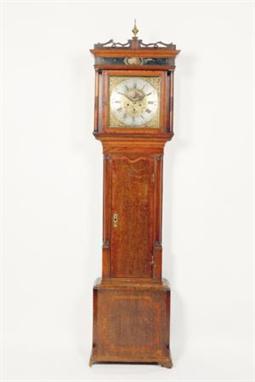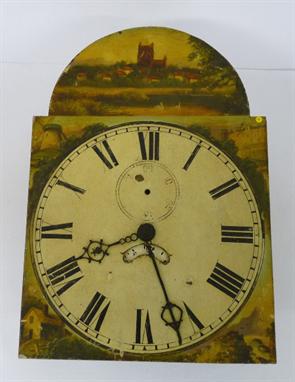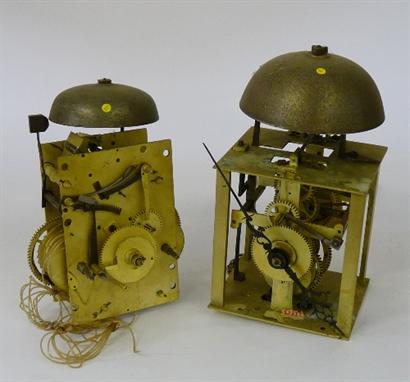We found 44425 price guide item(s) matching your search
There are 44425 lots that match your search criteria. Subscribe now to get instant access to the full price guide service.
Click here to subscribe- List
- Grid
-
44425 item(s)/page
An early 18th century walnut month going longcase clock, the 11" square brass dial inscribed `A.M.Cressener London`, with ringed winding holes, seconds and date rings, the five pillar movement with outside count wheel and with two massive brass weights, cut down and new with a later separate plinth, 203cm high
A George III longcase clock, signed Blackie, Musselburgh, arched, painted dial with subsidiary seconds and date dial, replacement movement with anchor escapement striking on a gong, in mahogany case, the hood with swan neck pediment, 6ft. 1in. - complete with pendulum, weights and winding crank
An 18th Century Stained Pine Longcase Clock by Joseph Kirk of Skegby (circa 1730). The 10½ inch (27 cm) square brass dial having maker`s name engraved on the chapter ring with Roman numerals counting the hours and Arabics counting the minutes, encircling a matted centre with round calendar aperture. The corners ornamented with scrolling spandrels cast with cherubs holding aloft crowns. The altered case having an inverted hood and cut down base, with a pendulum aperture to the long trunk door (lacking glass lenticle), 76¾ ins (195 cms) in height (A/F).
An 18th Century Eight Day Longcase Clock. The 12 inch (30.5 cm) square brass dial signed Ashton TIDSWELL on the chapter ring with engraved fleur-de-lys between the Roman numeral hour counters and outer ring of Arabic minute counters. The matted centre engraved with foliate scrolls and a compass rose, incorporating a subsidiary seconds dial and calendar aperture. The corners embellished with scrolling floriate spandrels. The oak case having a flat topped hood with moulded pediment raised on Doric columns flanking the dial. The cross-banded trunk inlaid with a compass rose. The base with alteration, 79 ins (201 cms) in height.
A 19th Century Oak Longcase Clock. The round painted dial decorated with a spray of honeysuckle and signed SAM HILL (place name indecipherable but possibly Sheffield) measuring 13 ins (33 cms) in diameter. The hood having a moulded swan-neck pediment with brass roundels adorning the terminals and fluted Corinthian columns flanking the dial. The mahogany cross-banded trunk having canted sides enhanced with inlay flanking a serpentine topped door, 84½ ins (215 cms) in height.
An 18th Century Eight day Longcase Clock. The 10½ inch (27 cms) square brass dial having two gilded ring-turned winding holes to the matted centre with calendar aperture, encircled by a chapter ring and embellished with fine scrolling face mask spandrels. The oak case ornamented with later intricate Victorian carving & `brickwork`, 80 ins (203 cms) in height.
A Small Walnut Longcase Clock with an 8 day movement signed John Ford Arundel. The silvered chapter ring enclosing a matted centre, a subsidiary seconds dial and a plaque inscribed with a makers name; bordered by ornate cast brass spandrels. The later case having a flat moulded hood above a fretted scroll frieze and ebonised barley-twist columns flanking the dial. The long trunk door veneered with burr walnut and bordered in ovolu moulding. Raised 79 ins (201 cms) in height, 17 ins (43 cms) in width, 9 ins (25 cms) in depth.
An 18th Century Mahogany Longcase Clock by George Jamison of London. The dial having a silvered chapter ring enclosing a decoratively engraved centre with a subsidiary seconds dial and calendar aperture. The arched top accommodating a strike silent dial flanked by pierced gilt brass spandrels. The pagoda style hood having two large brass ball finials and the glass door flanked by fluted columns with Corinthian gilt capitals. The canted trunk corners inset with brass reeds and flanking a flame-figured trunk door. 94 ins (239 cms) in height, 19 ins (49 cms) wide, 9 ins (23 cms) deep.
Victorian mahogany longcase clock , broken arch painted dial with rolling moon, figural spandrels personifying the Continents, Roman hours, subsidiary seconds and date rings, signed Summersgill, Preston , two-weight movement on a false plate, in a swan neck hood with twist columns on broad tunk and set-out plinth (no feet) Height 225cm (two weights, pendulum).
William Gill, Maidstone A mid 18th century lacquer longcase clock, the five pillar, eight-day duration movement striking the hours on a bell with internal rack striking, the twelve-inch arched brass dial engraved with wheatear border decoration, with the raised, silvered chapter ring engraved with black Roman numerals, Arabic outer five-minute numerals and ‘fleur-de-lys’ half-hour markings, the matted dial centre having engraved floral and bird decoration, ringed winding holes and having a subsidiary seconds dial and date aperture, with ‘female-head’ cast brass corner spandrels and blued steel hands, the silvered boss to the arch engraved with the maker’s name ‘Wm Gill, Maidstone’, the case of ‘tortoiseshell’ lacquer decorated with raised gilt chinoiserie work, with an arched trunk door, the arched hood with three-quartered columns to the front and two giltwood ball and spire finials, height: 200cm. * William Gill is recorded as working in Maidstone, Kent in the early 18th century having been apprenticed in 1704 and given his freedom in 1710. He is one of Maidstone’s most celebrated & competent clockmakers’ with a number of fine longcase clocks known by him. He supplied the clocks for a number of public buildings including both Rainham and St Nicholas of Leeds churches.
A mahogany moonphase longcase clock, the eight day duration movement striking the hours on a bell with the fourteen-inch painted arched dial having black Roman numerals, gilt floral corner spandrels and moon phase disc to arch, with decorative brass hands and subsidiary seconds dial and date aperture, the falseplate to the dial embossed with the dial makers’ name ‘Finnemore & Sons’ of Birmingham, the case profusely inlaid in various woods and having a short door, canted corners to the trunk, fluted hood pillars with brass capitals and a swan neck pediment, height: 250cm. * Finnemore & Son were well known Birmingham dialmakers’ with William Finnemore originally being part of the Walker & Finnemore partnership, continuing on his own account from 1812 and becoming ‘& Son’ from 1828 until 1836.
Wesley, Denham An oak longcase clock, the eight day duration movement striking on a bell with the twelve-inch painted arched dial having black Arabic numerals, floral corner spandrels, the decoration to the arch depicting swans on a lake, with brass hands, a subsidiary seconds dial and signed ‘Wesley Denham’, the false plate stamped with the dialmakers’ name ‘Francis, Birmingham’, the case having a curved trunk door, plain base, with the hood having fluted columns with brass capitals and three ball-and-spire finials to the moulded pediment, height: 225cm. * The dialmaker William Francis is recorded as working firstly in Thorp Street, then Old Inkleys and finally 11 Smallbrook Street, Birmingham from 1810 until 1831 and was a prolific maker.
An Oak Longcase Clock, the eight day duration movement striking the hours on a bell with the twelve-inch painted arched dial having black Roman numerals, subsidiary seconds dial, date aperture and blued steel hands, having a painting depicting Carew Castle within the arch and various rural scenes to the four corners, the falseplate to the dial stamped with the dialmaker’s name ‘Wilson, B/Ham’, the oak case having a plain base, arched door to the trunk, with three gilt-wood finials and turned three-quarter columns to the pagoda topped hood, height: 238cm. * James Wilson, working pre-1777 to 1809, was one of the pioneers of the Birmingham dial making industry having dissolved his partnership with the other well-known maker George Osborne in 1777. He was considered as one of it’s finest exponents as well as one of the most prolific. * Carew Castle, Pembrokeshire, was originally a Norman fortification developing into a fine Elizabethan country house and was the site of the last great tournament staged in Britain in 1507.
John Bennett, Plymouth A late Georgian longcase clock, the eight-day duration movement striking the hours on a bell with the twelve-inch arched brass dial having a subsidiary seconds dial, date aperture and engraved with black Roman hour numerals, floral corner decoration, with an engraved depiction of Father Time within the arch and maker’s name ‘J. Bennett, Plymouth’ to the centre, the stained case having an arched trunk door, fluted, canted corners to the trunk, turned pillars to the hood and surmounted by three wooden ball finials, height: 214cm. * John Bennett is recorded as working in Plymouth in the mid-to-late 18th century.
A GEORGE III OAK LONGCASE CLOCK with a brass dial signed "Major Schofield, Manchester", with subsidiary moon phase dial and date dial, with a silvered chapter ring within gilt spandrels with an eight day two train movement striking on a bell, the flat topped hood with a pierced gallery and brass finial, the trunk with tall door with shaped top flanked by quarter recessed columns, 89" high. See illustration
A GEORGE III PROVINCIAL OAK LONGCASE CLOCK by Oldham, Southam, the case with crossbanded long door and square hood with turned tapering columns surmounted by a blind fret frieze and stepped pediment, the square silvered dial with Roman and Arabic numerals to the chapter ring and date aperture, the thirty hour movement striking on a bell, 69". See illustration
AN 18TH CENTURY OAK LONGCASE CLOCK by John Ramsbottom Hall-Green, the case with long crossbanded door surmounted by a square hood with turned columns, the brass dial with Roman and Arabic numerals to the chapter ring, pierced spandrel, subsidiary "penny moon" dial and date aperture, with two train eight day movement, 80". See illustration
A DUTCH MAHOGANY AND FLORAL MARQUETRY LONGCASE CLOCK, the brass arched dial inscribed "Fromantell and Clark", the case with long door inlaid with ferns, flowers and swags, with an oval neo-classical urn brass lenticle, the hood with square tapering pilasters with gilt brass finials, surmounted by a blind fret frieze and architectural pediment, the brass dial with serpent and mask spandrels, with a silvered chapter ring with Roman and Arabic numerals, the matt centre with subsidiary dials for alarm, seconds and date, the two train movement striking on a bell, 95" high. See illustration
A WILLIAM IV OAK AND MAHOGANY LONGCASE CLOCK by D. Herbert, Aberistwith, the case with quarter fluted columns above a hood with turned columns and swan-neck pediment and urn finial, the arched brass dial painted with rural scenes with Roman numerals, subsidiary seconds dial and date aperture with two train eight day movement striking on a bell, 90". See illustration
AN EARLY 18TH CENTURY CHINOISERIE LACQUERED LONGCASE CLOCK by George Avernell, Farnham, the tall slender case with a black ground decorated with gilt and polychrome chinoiserie scenes and diaper panels, the square hood with turned columns and stepped pediment, with gilt ball finials, the brass arched dial with lion, unicorn and coronet-mounted name tablet flanked by dolphin and scroll spandrels, the silvered dial with Roman and Arabic numerals enclosing a matt centre with subsidiary seconds dial and date aperture, the two train movement striking on a bell, with two brass cased weights 96". See illustration
ISAAC GODDARD, LONDON, an eight day longcase clock dial and movement, the 30cm square brass dial with Roman numerals, Arabic five minute intervals, half hour markers, matted centre, subsidiary seconds, ringed date aperture and winding holes, foliage, cherub and crown spandrels, engraved wheat-ear border, the 5 pillar movement with anchor escapement and inside countwheel, striking on a bell
WILLIAM PREDDY, TOTNES, a mahogany longcase clock the 35.5cm painted, broken arch dial with Roman numerals, seconds dial, calendar aperture and signed in the centre "Preddy Totnes" the four pillar movement mounted on a false dial plate with anchor escapement, rack striking on a bell, the case with broken arch pediment, writhen columns, short trunk door flanked by similar columns, panelled plinth and bracket feet, 230cms high (with 3 brass eagle and ball finials, pendulum weights & key)
TYTE, WELLS, a mahogany longcase clock, the 33cms painted broken arch dial signed in the centre "C Tyte Wells" with Roman numerals, seconds dial, calendar aperture, pierced gilt hands, floral spandrels, the arch with figures and a castle beyond, the four pillar movement mounted on a false dial plate, with anchor escapement, rack striking on a bell, the case with broken arch pediment, writhen columns, short trunk door, panelled plinth and bracket feet, 224cms high (with finials, pendulum, weights & key)
GEOe WILLIAMS, AXBRIDGE, a brass 30cm broken arch longcase clock dial with Roman numerals, Arabic five minute intervals, seconds dial, calendar aperture, etched spandrels representing the seasons, Phase of the Moon arch and "High Water at Swansea" the four pillar movement with anchor escapement, rack striking on a bell (defects)
An oak longcase clock, signed Robert Davey, Hoveton, 18th century, oak case, fretted pediment, arched door with radiating marquetry lunette, herringbone stringing, arched brass dial, rocking ship motif to the lunette, inscribed - "The Royal George", cast spandrels, second dial and date aperture, eight-day movement, striking on a bell, 225cms, (88½").
Oak and mahogany longcase clock signed X Reiner, Oxford early 19th Century with rosewood cross banding stringing and Tunbridge ware banding, broken swan-neck pediment, shaped door plinth base, arch painted dial, subsidiary second dial and date aperture, painted floral spandrels, river landscaped scene to the lunette, thirty-hour movement, 214cms (84")
A late 18thC oak longcase clock, with swan neck pillared hood, full length moulded trunk door with shell inlay, raised plinth base, 30cm brass dial having armorial spandrels, chapter ring with Roman hour and Arabic minute numerals, matted centrefield with subsidiary seconds ring, Ho-ho bird chased decoration around the date aperture and marked to the chapter ring Jn Stockeld, Lincoln, eight day movement striking a bell, 193cm high.
A George III oak 8-day longcase clock, maker Alexander Nimmo of Linlithgow, the arched brass dial with makers name and numbered 170 above a brass Roman/Arabic numeral chapter with subsidiary seconds dial and date aperture, the swan neck hood above a ogee shaped door, on a plinth base with bracket feet, 228cm high x 50cm wide
James Pepper of Biggleswade, A George III oak longcase clock, the silvered face with secondary dial, date aperture and gilt spandrels supporting a twin train striking movement under an arched hood, the case with conforming moulded door, on a plinth base with bracket feet * The Peppers of Biggleswade traded as watch and clock makers in the town from 1721-1870
-
44425 item(s)/page


















































